#Chitragupta temple
Video
youtube
chitragupta Temple in Kanchipuram | chitragupta temple | Tamil Nadu | A ...
0 notes
Text
Explore the Spiritual Marvels of The Chaurasi Temple Complex in Bharmour
Himachal Pradesh, often hailed as Devbhoomi, the land of Gods, boasts a rich mythological past and is home to numerous temples that attract devotees from across the globe. Nestled in the heart of this divine landscape is Bharmour, a region known for its beautiful and ancient temples dating back to the 7th century AD.
Among these sacred shrines, the Chaurasi Temple Complex stands out as a…

View On WordPress
#7th century AD#84 temples#Bhai Dooj#bharmour#chamunda devi#Chaurasi Temple Bharmour#Chitragupta#Dharamraj#Lakshana Mata#Lord Ganesha#Lord Hanuman#Lord Nandi Bull#Lord Narsimha#Lord Shiva#Lord Yamraj#Sheetla Mata#Shri 108 Jai Krishan Ji Giri (Naga Baba)#Swami Kartikeya
0 notes
Text
The second archetype I'll be talking about is what I like to call "the death archetype" this includes deities of the underworld and just deities of death. The following is a list of deities I'll be talking about: Hades, Thanatos, Charon, Anubis, Mictlantecuhtli, Chitragupta
Hades: god of the underworld but not of death itself in Hellenism. Eldest son of Cronus and Rhea. Boss of the underworld which shares his name. Husband of Persephone. Has a three headed guard dog called Cerberus. He is usually portrayed having a bident in his hand and wearing a helm. Was seen as a fearsome figure so much that people averted they're eyes while sacrificing to him and used epithets such as Pluto.
Thanatos: god of specifically peaceful death in Hellenism. Brother to Hypnos and son of Nyx. Was usually a very peaceful god but has a tendencie to lash out and enter a rage when people avoid they're death such as in the case of Sisyphus. A very minor god often being referred to but not often appearing. He is usually depicted as a young man with only a left wing while his Brother has only one right wing.
Charon: The ferryman of the underworld in Hellenism. He brings the souls of the dead to Hades across the river Acheron but only for coins. If a soul didn't have coins they would be lost in Hades for 100 years until they reach the afterlife. For that reason ancient greeks would give they're dead coins before burying them.
Anubis: Judge of the dead god of funerary rites, protector of graves, and guide to the underworld in Egyptian mythology said to take the heart of a dead person and a feather on a scale if the heart was heavier than the feather they would be condemned into eternal punishment. Son of Nepthys and Set. Often depicted as a man with the head of a Canine
Chitragupta: registar of the dead in Hinduism. Tasked with maintaining a register of the dead called the Agrasandhanī. After tge death of a human being Mictlantecuhtli would read out the deeds of the human to actual god of death, Yama so he can decide if a soul gets into either Svarga or Naraka. It was said that he was created from Brahma's soul and mind
Mictlantecuhtli: is the god of death and king of Mictlan which is the lowest and northernmost point of the underworld in Aztec religion. His worship often involved cannibalism in or around a temple of his. He was often depicted as being 6 feet tall and was depicted as a blood splattered skeleton.
I have to say the death archetype is one of my favorite archetypes. I decided to include three from Hellenism because I myself am one.
If I got anything wrong please tell me so in the comments ::)
7 notes
·
View notes
Text
Baishi Pahacha Odia Book By Pandita Daityari
Baisi Pahacha is a mix of two words 'Baisi' and 'Pahacha'. In nearby Odia language 'Baisi' signifies '22' and 'Pahacha' signifies 'Step', so 'Baisi Pahacha' signifies '22 Stages'. These 22 stages found at the 'Simha Dwara', the Lion's entryway of Master Jagannath sanctuary, Puri. Subsequent to entering the Lions' door of the sanctuary, lovers need to climb these 22 sacred moves toward arrive at the second internal entryway (known as Baisi Pahacha Gumuta), in the wake of passing the second entryway they will arrive at the patio from where they can get into the fundamental sanctuary to see Ruler Jagannath.
According to belief, all sins of the devotees disappear who touch these steps even once, so devotees usually touch these 22 steps in hand while climbing them and also allowed their children to slowly roll over these steps from the top to the bottom in expectation of spiritual bliss. Pilgrims get a sense of fulfillment after putting a fleck of dust from the surface of these 22 steps on their forehead. Width of the middle 15 steps varies from 5 feet 10 inches to 6 feet 3 inches and the rise is 6 inches to 7 inches. The size of the remaining 7 steps is smaller in length and width. A black color stone known as 'Yama Shila' is engraved in the middle of the 3rd step. As per the belief, devotees must step on this stone while going up the steps because it frees themfrom 'Yama Danda' (Punishment of Yama, the God of death), ' but must not step on this stone on their way back since it will take away all the 'Punya' (values collected after visiting Lord Jagannath temple).
Various holy activities and rituals are performed on these 22 steps throughout the year, out of those 'Sradha' ritual is the most important one. Sradha is the annual Pinda Daana ritual of Hindus, a ritual in which food is offered to the ancestors, is usually performed on both sides of these 22 steps. The ancestral souls are believed to be satisfied by it. There is a small stone on the 7th step known as 'Pitru Shila'. Devotees offer Anna Mahaprasad, the holy rice of the temple that has been offered to Lord Jagannath, to this stone for feeding their ancestors to liberate their departed souls. It is also believed that during the annual car festival several Gods, Goddesses, Demi Gods, other heavenly bodies, the souls of the ancestors (near the Pitru Shila), Chitragupta and Yamadootas (near the Yama Sihla)came to these steps to see the grand Pahandi ceremony of Lord Jagannath. Madana Mohana, the representative idol of Lord Jagannath, offers Pinda Daana on these steps to his ancestors (Nanda and Yashoda, Devaki and Vasudeva, Koushalya and Dasaratha). Another ritual known as 'Badabadia Daka' (call the elders) is performed on these steps on the day of Deepavali. Devotees burn kaunria kathis (bundle of a particular kind of sticks which easily catch fire) on these steps on the Deepavali day to light up the path of their ancestral souls. The idols of Kasi Biswanath, Lord Rama, Nursingha and Ganesha have been installed on the southern side of the Baisipahacha.
2 notes
·
View notes
Text

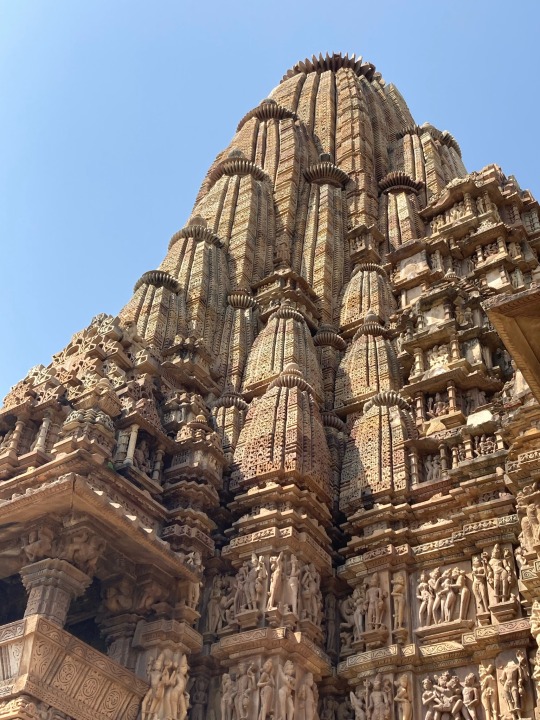

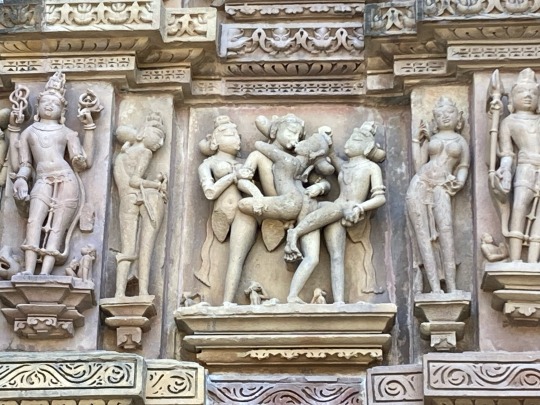
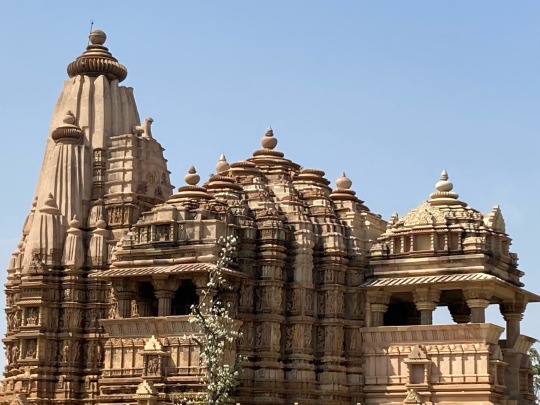

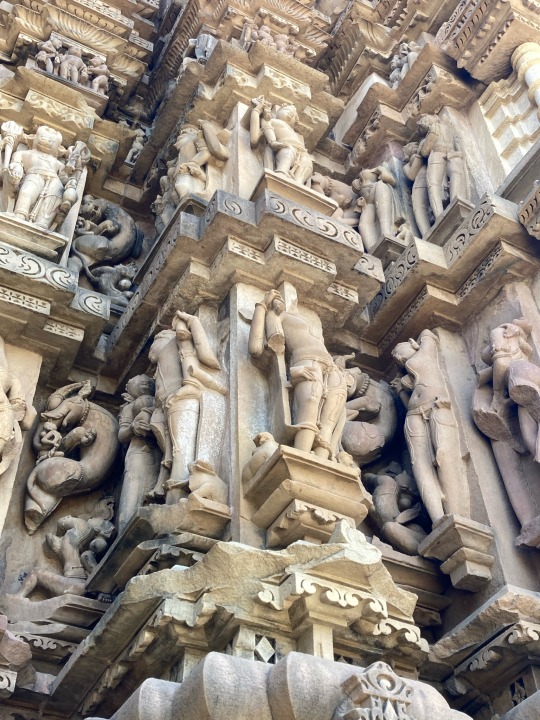

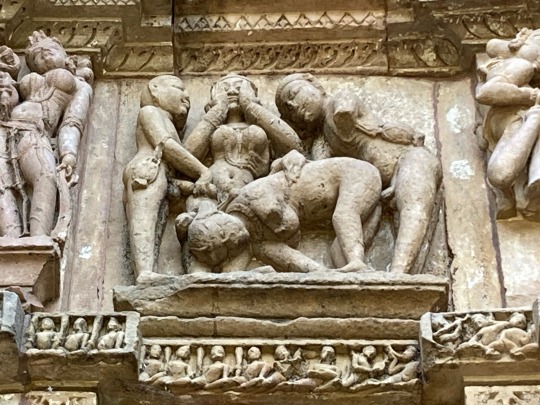
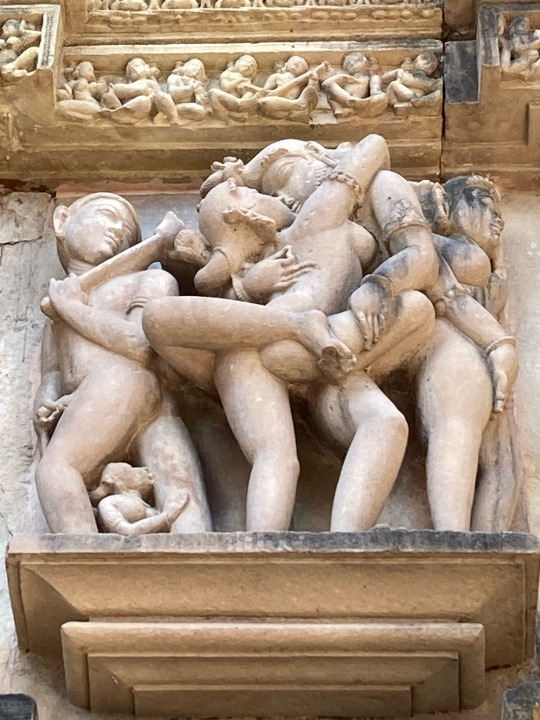
I finally made it to Khajuraho today, after two (lengthy) train journeys. I missed out on Khajuraho, along with Hampi, when I visited India last year and was determined to see them this time.
So what’s here you ask, well temple and a lot of them (though not as many as there was. The Khajuraho Group of Monuments are a group of Hindu and Jain temples, there were well over 80 no now there are about 22 left. I only had time to explore the Western Group, but those are the main ones.
The temples are probably best know for having some ‘erotic’ carvings and there are some scattered in the photographs I took. I probably missed quite a lot of the erotic art as I wasn’t overly looking for it - I did see you could get a tour guide just to see it all! The erotic stuff is only on the outside of the temples, nothing untoward inside.
The Khajuraho temples were built between 885 and 1000 CE by the Chandela dynasty. The temple complex was forgotten and overgrown by the jungle until 1838 when Captain T.S. Burt, a British engineer, came across them.
There is a logically route to follow. I started with the biggest temple - the Kandaria Mahadev Temple, it is dedicated to Shiva and has many spires to resemble Mountain Kailasha in Himalayas. Next up was the Devi Jagadambi Temple, followed by the Chitragupta Temple. The Parvati Temple was next followed by the Visvanatha Temple and Nandi Shrine. The last temples I visited were the Pratapeshwar Temple, Laksmi Temple, Varaha Temple and Lakshmana Temple which were in their own section.
0 notes
Text
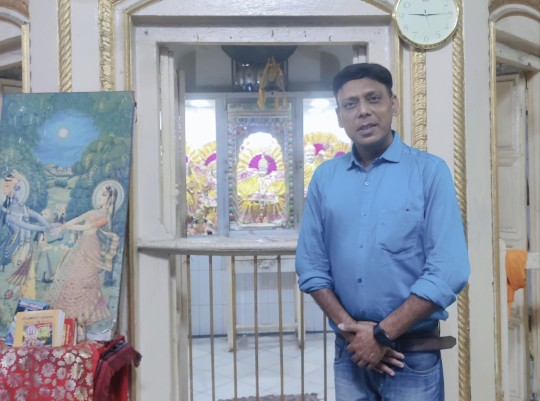
At Shri Chitragupta Temple, New Delhi.
#newdelhi
#SanjaySinha
1 note
·
View note
Link
This is the only Chitragupta temple in South India. It is a unique temple. Devotees visit the temple as a remedy for afflictions of Ketu.
0 notes
Text
Chitai Golu Devta Temple Uttarakhand
Chitai Golu Devta Temple is a Hindu temple dedicated to Chitragupta, situated in Almora, Uttarakhand, India. Chitragupta is considered to be the patron deity of accountants and bookkeepers. The temple was built in the 18th century by the then king of Almora, Baz Bahadur Singh. It is a popular pilgrimage site for Hindus, who come here to offer prayers and seek the blessings of the deity.
The temple is situated at a distance of about 6 km from the main town of Almora. The best time to visit the temple is during the months of October to March, when the weather is pleasant and cool.
The main attraction of the temple is the idol of Chitragupta, which is made of black stone. The idol is adorned with gold and silver jewellery. devotees offer prayers and make offerings of fruits, flowers and sweets to the deity.
0 notes
Text
The Shri Chitragupta Adi Mandir Management Committee, under able leadership of its President — leading businessman and social worker Honourable Chairman Sir’s Ravindra Kishore Sinha —, has drawn up an elaborate plan to develop the temple complex as a modern structure built upon its historic moorings. The idea is to develop the shrine and the area surrounding it as a socio-religious centre that can figure on the international tourist landscape and serve the needs of the local community, simultaneously. One of the projects announced by Mr. Sinha include the creation of an animated audio visual walk-through showcasing the of culture and history of Bihar, beginning from the Nanda dynasty and culminating with the modern-day, 1970s leadership of Lok Nayak Jayaprakash Narayan.
Along with the ancient kingdoms, the song-and-light show encompass historical events like the visit of Chinese traveller Huein Tsang, era of the ancient Nalanda University, Vaishali as the cradle of democracy, the
Patna Kalam style of painting, the Mughal and British rules, the works of Vidyapati, the timers of Manadan Mishra and Bharati who defeated Adi Shankaracharya in Shastrartha, famed dancing of Amrapali and Bihar’s place in the Indian freedom movement. Another one is to establish the “Raja Todarmal Institute of Revenue and treasury Management”. A third major project is to develop the Ganga river bank near the temple on the pattern of “Har ki Pauri”, in Haridwar. The cost of the projects has been tentatively estimated at British Pound 10 million (about Rs 80 crore) but an upward revision may be required.
A cause to serve
The Shri Chitragupta Adi Mandir resurrection plan offers all Indians, particularly those who constitute the diaspora, an opportunity to delve into their history and socio-religious moorings. A monetary contribution from you will help create out of an ancient setting an international cultural destination par excellence, in the heart of what was once the vibrant city of Pataliputra. Give it a thought: it may just be your article of faith!
0 notes
Video
youtube
చిత్రగుప్తుడు గుడి ఎక్కడుందో మీకు తెలుసా? | Do you know where the Chitra...
0 notes
Text
Stately Khajuraho, expressing the love and heritage
Khajuraho an ancient city located in the Chhatarpur district of Madhya Pradesh is known for it’s magnificent temples and intricate sculptures. These sculptures are built in the medieval period by the Chandela Dynasty, the UNESCO site of the ‘Khajuraho Group of Monuments’ is famous for its Nagara-Style architecture and graceful sculptures of female protagonists of Indian mythologies called ‘Nayikas’ and the Hindu deities.
Features of the sculptures carved on the temples
Built between 950–1050 AD, these temples represent various forms of meditation, spiritual teachings, and relationships, through stimulating art. The first recorded mention of the Khajuraho group of temples comes from the written archives of Abu Rihan al-Biruni in 1022 CE and the well-known traveler from Arab, Ibn Batuta. The majority of these temples are made up of sandstones of different colors except the Chausathyogini, Brahma, and Lalguan-Mahadeva temples which are made from granite. These stones are likely to have been obtained from the Panna quarries on the eastern side of the river Ken.
The Khajuraho Group of Temples is divided into three groups: Eastern, Western and Southern. Beautiful, detailed, and expressive, the sculptures of the Khajuraho temples will leave you in awe and wonder.
Here are some of the best places to visit in and around Khajuraho that you must add to your bucket list
Kandariya Mahadev Temple
This world famous temple has approximately 870 majestic sculptures carved on the interior and exterior walls. The sanctum has beautiful floral carvings and the interior has a Shivlinga. Three sections of the outer wall depict statues of gods, goddesses, and mythological creatures. There are many other temples and sites like Chaunsath Yogini, Chitragupta, Vishwanath and Lakshmana temples in the western group.
Bhagawan Parshwanath Digambar Jain Mandir
This is the biggest Jain temple among the eastern group which is meticulously detailed. The Parsvanath sculpture was placed in the year 1860. On the northern exterior wall, the sculptures are quite interesting and depict ordinary life in artistic ways. Within, a throne is positioned in front of the bull symbol of Adinath, the first Tirthankara.
Sound & Light Show
This enthralling sound and light show showcase the lives and times of the great Chandela Kings and the historical chronicles of the magnificent temples built in the tenth and eleventh centuries. The 50-minute spectacle, which is projected on the complex of the Western Group of temples, is performed in Hindi and English every evening. The Indian megastar Amitabh Bachchan narrates the tale of Khajuraho in his pre-recorded mesmerizing voice.
State Museum of Tribal and Folk Arts
At the Chandela Cultural Complex, a magnificent collection of masterpieces of tribal and traditional arts and antiquities from all around Madhya Pradesh are on exhibit. The State Museum’s collection includes around 500 art pieces of terracotta, metalwork, woodwork, tribal and folk art, tattoos, jewelry, and masks. The museum is open from 12:00 noon to 8:00 p.m., on all days except Mondays and government holidays.
Raneh Water Falls
This fall is located on the magnificent Ken river. Here, the primary attraction is the 5-kilometer-long, 100-foot-deep Canyon of Crystalline Granite. This granite features pink, red, hazy white, green, and grey shades.
Panna National Park
Panna National Park, which stretches along the Ken River, is a 30-minute drive from Khajuraho. Other than the tiger, various magnificent species such as the leopard, wolf, and crocodile may be seen here. One can also sight Herds of Blue Cow(Nilgai), Chinkara, and Sambar in Panna National Park. There is a marvellous Pandav Falls nearby.
Tomb of Maharaja Chhatrasal
Maharaja Chhatrasal (4 May 1649–19 December 1731), was a medieval Indian warrior who fought against the Mughal Emperor Aurangzeb, and established his own kingdom in Bundelkhand, becoming a Maharaja. The tomb of Maharaja Chhatrasal is an octagonal structure built in the 18th century A. D.
If you are planning a trip to Khajuraho in February, you can be a part of the Khajuraho Dance Festival and witness the magnificent city unveil its architectural glory, as renowned artists perform in the backdrop of the historical monuments. This grand cultural extravaganza is a stunning blend of art and architecture.
Source URL- https://www.mptourism.com/stately-khajuraho-expressing-the-love-and-heritage.html
1 note
·
View note
Photo

Chitragupta Temple, Kanchipuram, Tamil Nadu
Thiru Chelvi रुद्र ॐ wrote :
✨Yamam Dharmarajya Chitraguptaya vain namah ✨
Chitragupta temple is a Hindu temple located in Nellukara Street Kanchipuram in the South Indian state of Tamil Nadu. It is one of the rare temples of the Hindu deity Chitragupta, considered as an assistant of Yama, the Hindu god of death. 🔥
Chitragupta is assigned with the task of keeping complete records of actions of human beings on the Earth. Upon their death, Chitragupta has the task of deciding heaven or the hell for all the humans, the birth of various life forms in superior or inferior species and rewards and punishments according to the sins and virtues, depending on their actions on the Earth 🌍
(via Instagram: Thiru Chelvi रुद्र ॐ)
43 notes
·
View notes
Text
<!--td {border: 1px solid #ccc;}br {mso-data-placement:same-cell;}-->Adi Chitragupta Mandir is a famous ancient temple of Lord Chitragupta located on the banks of river ganga, near Patna City, Bihar.
0 notes
Text
art.sensuality.hinduism . an equisite perfection of sculptures ~KHAJURAHO

~ kandariya mahadev temple
Khajuraho was an ancient city in the Madhya Pradesh region of northern India. From the 10th to 12th century CE it was the capital of the Chandella kings who ruled Bundelkhand. Khajuraho is popular for its group of artistic temples which were built by the Chandela rulers between the 10th and 12th Century. Chandela rulers were the great patrons of art and this is the reason that the Khajuraho group of temples is known for its sculptural wealth. Despite Khajuraho’s once great reputation as an important cultural centre there are no surviving non-religious buildings, but the presence of 35 Hindu and Jain temples make it one of the most significant historical sites in India today and worthy of its name given by the 11th century CE Muslim historian Abu Rihan Alberuni as ‘the City of the Gods’. Khajuraho is listed by UNESCO as a World Heritage Site.There were some 85 temples constructed during the aforementioned period but only 25 temples remain in the complex today.
The Khajuraho temples are even mentioned in the records of Al Biruni and Ibn Battuta. All the temples are built out of fine sandstone except Chausath Yogini, Brahma and Lalguan-Mahadeva temples constructed out of granite.
HISTORICAL BACKGROUND ~
Most of the Khajuraho temples were built between 950 and 1050 CE during the Chandela Dynasty. According to histories, the temple site had 85 temples by 12th century and 25 only survived, of which the Kandariya Mahadeva Temple built by King Vidyadhara is the famous for its intricate sculptures and arts. Kings Yashovarman and Dhanga are famous for their construction of The Lakshmana Temple and Vishvanatha Temple respectively.
Many of the currently surviving temples contain inscriptions that most of them are built between 970 and 1030 CE. The first recorded mention of the Khajuraho temples is in the accounts of Abu Rihan al Biruni in AD 1022 and the Arab traveler Ibn Battuta in AD 1335.
Khajuraho is believed to be the religious capital of Chandelas. The group of temples was enclosed by a wall with 8 gates, with each gate flanked by 2 date/palm trees. Hence, it is called as Khajura-vahika meaning Date Bearing. Khajuraho is also mentioned as Jejakbhukti in historical records.After the fall of Chandela Dynasty, Muslims invaded the region and the temples were hidden under forests from 13th to 18th century until they were rediscovered by T.S. Burt, a British surveyor in 1830.
The Chandelas were followers of the Tantric cult which believes that gratification of earthly desires is a step towards attaining the ultimate liberation. Tantrism has been mostly misunderstood and the Philosophical part of Tantras like the Mahanirvana Tantra have been totally forgotten. This was one of the reasons why Tantrics perished. Nevertheless it remains a distinct path of Spiritual Practice though it has very few followers all over the world.
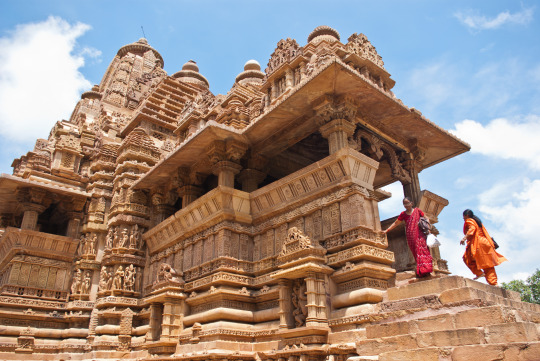
Categories of Sculptures
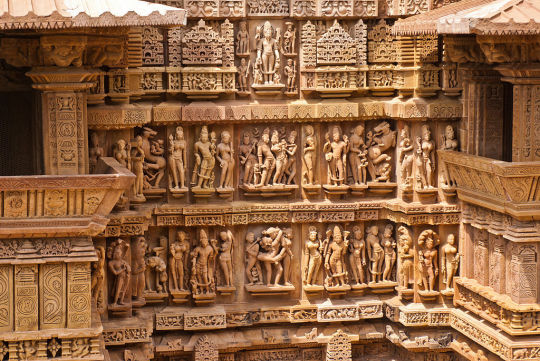
Based on their nature, the sculpture in Khajuraho is categorized into five. The first group of sculptures is the cult images. The second category of images that occur in the niches comprises of enclosing divinities, family, and the attendants. The third and the most dominant group of sculptures are that of the apsaras and the sura-sundries who are portrayed in dancing postures and graceful nymphs respectively.
The fourth group of sculptures is secular images depicting scenes like teacher and student, dancer and musicians, erotic couples, etc. The last category of sculptures is that of animals including the mythical beasts. We find the sculptural art at its zenith in the Kandariya Mahadeva Temple.

~a close architectural overview of Kandariya mahadev temple, khajuraho.
The Importance of the Erotic Sculptures
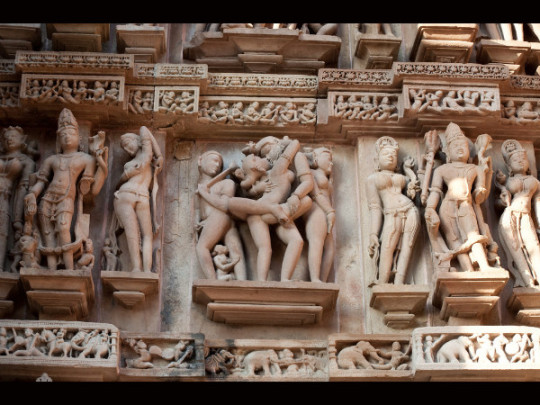

Amongst all the group of sculptures mentioned, the erotic sculptures are considered to be exemplary in highlighting the sensuous human emotion. To quote art historian Krishna Deva, ‘the sculptural art of Khajuraho surpasses the medieval school of Orissa in revealing the sensuous charms of the human body’. Some consider the erotic sculptures as an illustration from the ancient text of Kamasutra. The stress is laid on considering sex as a source of creation. The sensual element has always been described in the ancient literature and folk tradition.
Western, Eastern and Southern Group of Temples
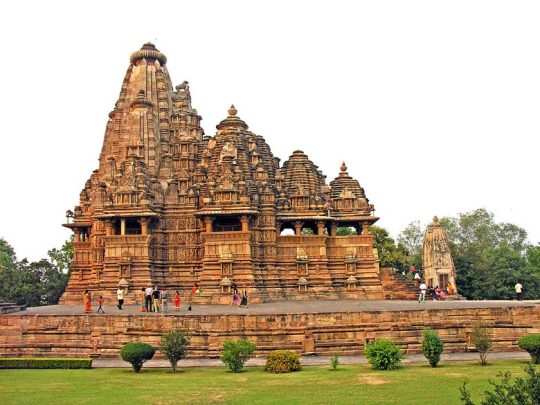
~ Vishvanath temple
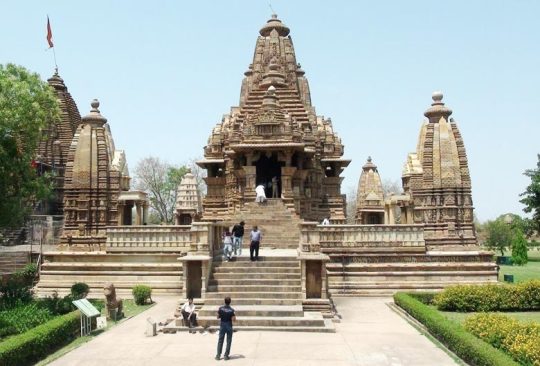
~Lakshmana temple
The western group of temples is the most visited ones by the tourists. It comprises the Lakshmana temple, the magnificent Kandariya-Mahadeva Temple, Chitragupta temple and Vishvanath temple. Kandariya Mahadeva is the largest monument in Khajuraho with its architecture depicting the splendid and considerably taller sculptures and also the Central style of architecture. The eastern group of temples includes the Brahma temple, Vamana temple, and other Jain temples.
Means of Transport ~
By Air: The nearest airport is Delhi International Airport. From Delhi , a connecting flight plies to the Khajuraho Airport which is 2 km from the Khajuraho City.
By Train: Khajuraho has its own railway station named after the famous temple. The railway station is around 5 km away from the popular tourist spots of Khajuraho. Rental cars are available from the station premise to Khajuraho temples.
By Road: Khajuraho is well connected by roadway to major cities like Jhansi, Orchha, Katni, Chattarpur etc. Many kinds of buses are available that one can select from to reach Khajuraho from different parts of North India.
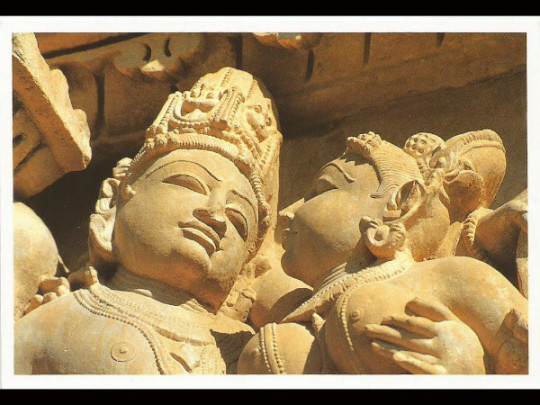
‘The basic Universal Divine Energy (Shakti) is a symbol of the union of man and woman and it is the main spiritual emotion in Hindu art depicted in the man-woman sculptures seen in Amravati, Khajuraho, Konark, etc.Here Divine Energy (Shakti) manifests in the man-woman union, the basis of Vedic art and culture. Sculptures in the Ajanta caves are also a depiction of the man and woman, but sexual congress is prohibited in the sculptures’. Bharatiya SanskrutiKosh, pages 166-169
29 notes
·
View notes